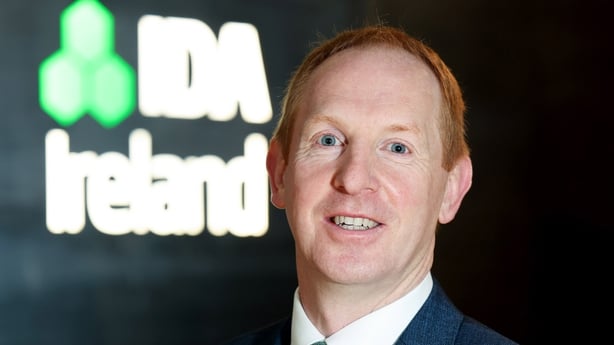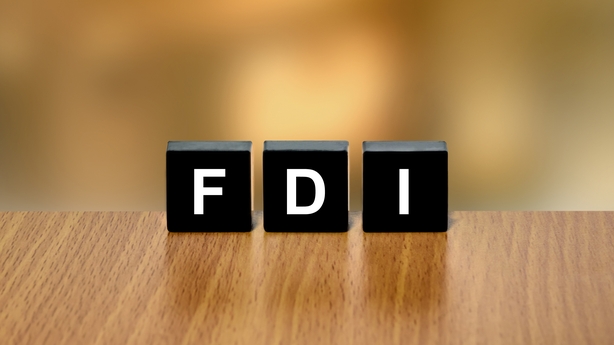"Our phones are hopping and the town is overjoyed at this great news."
That was the reaction of a local business owner in Athenry, Co Galway in May when it emerged that US continuous glucose monitoring technology provider, Dexcom, was to set up a manufacturing site in the town, creating 1,000 jobs.
It was one of the biggest foreign direct investment (FDI) announcements made by any company during the first six months of the year, accounting for around one 12th of all jobs potentially to be created as a result of all FDI decisions made here between January and June.
On Wednesday, in a mid-year update, inward investment agency IDA Ireland revealed that a little over 12,000 new jobs had been pledged by foreign multinationals during the first half of 2023, through 139 projects.
That result was, however, down quite considerably on the same six-month period a year earlier, when 18,000 new roles were promised from 155 investments.
The drop immediately begged the question, should we be worried?

"There is nothing to be worried about," was the reassuring answer from the IDA Chief Executive, Michael Lohan, who claimed the out-turn was in line with expectations.
He explained that 2022 had been a record year in FDI in Ireland, as global firms bounced back from the pandemic and tech firms in particular reaped the rewards of a shift in how people worked and lived.
As a result, the investment figures for the first half of 2022 were unusually high, leaving the performance from January to June this year looking instead a bit more like that recorded in the years prior to last year.
"These numbers absolutely reflect and are actually either on par with or slightly ahead of our numbers from 2019, or indeed 2018 or 2020 for example," Mr Lohan said.
It is an assertion somewhat borne out in the figures, with 12,530 jobs pledged from 142 investments in the first half of 2021, 9,600 from 132 in the first six months of 2020, 13,500 from 140 projects in the same period in 2019 and 11,300 from 139 decisions over the same timeframe in 2018.
Tech is one thing. But there is also a slight question mark over-hanging the pharma sector here too.
But why then did the strength and momentum of FDI last year not follow through into this year?
The IDA explained that first there was the fragility of the global economy arising from the ongoing geopolitical tensions, inflation and associated rising interest rates.
That's all weighed on sentiment among firms and the agency claims that as a consequence foreign direct investment into Europe so far this year has been broadly flat.
Other challenges include the evolving investment landscape internationally, as countries adapt their industrial policies to focus on strategic sectors and the acceleration of the green and digital transition, leading to changes in FDI flows.
Examples include the Inflation Reduction Act in the US and the European Chips Act closer to home.
But there is also missing piece to the jigsaw presented by the IDA last week and that’s jobs lost.
The agency only collates the number of positions that have shed by its clients once a year, in the autumn, and so is not in a position to say now how many roles have been quashed since January.
For the past year though, there has been a high-profile retrenchment of the tech sector globally, as it became apparent that the hyper-growth experienced by many ICT firms during the depths of the pandemic was not going to continue, leaving most over-staffed.
In March, the Central Bank put a figure of 2,300 on the number of workers in tech firms with operations in Ireland who had lost their jobs and since then there have been many more redundancies.
The IDA also conceded that it cannot rule out further job losses in tech before the end of this year.

We’ll therefore have to wait until then to see what affect the tech travails have had on the overall employment numbers in foreign multinationals here.
But the Minister for Enterprise, Simon Coveney, and the IDA’s Michael Lohan both expressed confidence that the overall net position on job creation at year end would be a positive one.
"My sense is that at this juncture is that we will actually be in a net positive position at year end and the reason I can say that at this juncture is that we've had a very strong first half as our numbers today reflect," said Mr Lohan.
"But secondly, I think as we look towards the pipeline, our opportunities to deliver…those investments between now and year end is also quite strong. So if all of those elements come together, which I believe they will at this juncture, we will be in a net positive position at year end."
Tech is one thing. But there is also a slight question mark over-hanging the pharma sector here too.
Last month it emerged that there had been a €5bn or 5% fall-off in exports of medical and pharma products over the first four months of the year, which triggered the first drop in the State’s headline exports in nearly a decade.
The big-pharma and wider life sciences sector is the jewel in the crown of Ireland’s FDI mix, making up a third of the IDA’s employment base, with over 100,000 employed.
Any retrenchment would clearly therefore be a big concern.
But the IDA believes this too is a blip. It thinks the size and scale of investments announced by the sector here in recent years points to longevity and plans for future growth.
What may be happening though, it thinks, is that as some products come off patent they are being replaced by new ones, leading to a temporary glitch in exports ahead of a rebirth in production and normal business resuming.
So clearly many external forces play a massive role in the success of Ireland’s FDI base.
But so too do internal ones.

Last month, the latest IMD World Competitiveness Rankings found Ireland was the second most competitive economy out of 64 analysed.
But how long can Ireland maintain that position in a high inflation, high interest rate environment, when the economy is running at full capacity and the Exchequer’s coffers are overflowing?
A deeper dive into the research revealed that while Ireland ranked high on economic performance, Government efficiency and business efficiency, it performed far less well when it came to infrastructure.
The IDA underlined its concerns in this regard when it warned FDI will only be well placed to continue to drive growth provided enabling infrastructure challenges in the economy are urgently addressed.
Specifically, what it is referring to here is reform of the planning system, the need for more houses, the requirement to boost and green Ireland’s energy production capacity, the importance of ensuring sufficient water supplies and in general better infrastructure all round.
None of this comes as a surprise - the IDA and other organisations representing businesses have been warning about these concerns for some time.
The difference now is that clearly Ireland’s economy is bursting at the seams, with full employment, stubbornly high levels of core inflation and huge budget surpluses.
If this situation is not addressed and quickly, through the provision of improved infrastructure to boost the economy’s carrying capacity, then Ireland’s competitiveness could slip and with it the country’s attractiveness as a place to invest.
Recently, Mr Lohan’s predecessor as IDA boss, Martin Shanahan, who now works as a consultant for Grant Thornton, underlined the risk of poor infrastructure threatening to hinder job creation.
"More than anything else this runs the risk of deterring new investment," he said at an event at the Institute of International and European Affairs.
He also warned that Ireland has no inherent right to multinational investment and can’t become complacent.
The Government says it recognises the risk and acknowledges more needs to be done.
"The Government does need to focus on investing in infrastructure, particularly around energy and housing to make sure that actually we can keep the capacity in place to facilitate that kind of growth into the future," said Minister Coveney on Wednesday.
"And that's why you'll see the Government continuing to commit more capital for that kind of infrastructure."
That’s a pledge the IDA will be very much hoping is followed through on.
Because while it’s clear that it may have reason to be cautiously confident today about what lies ahead over the second half of this year, the view of what may be coming further off into the horizon is far less clear.







